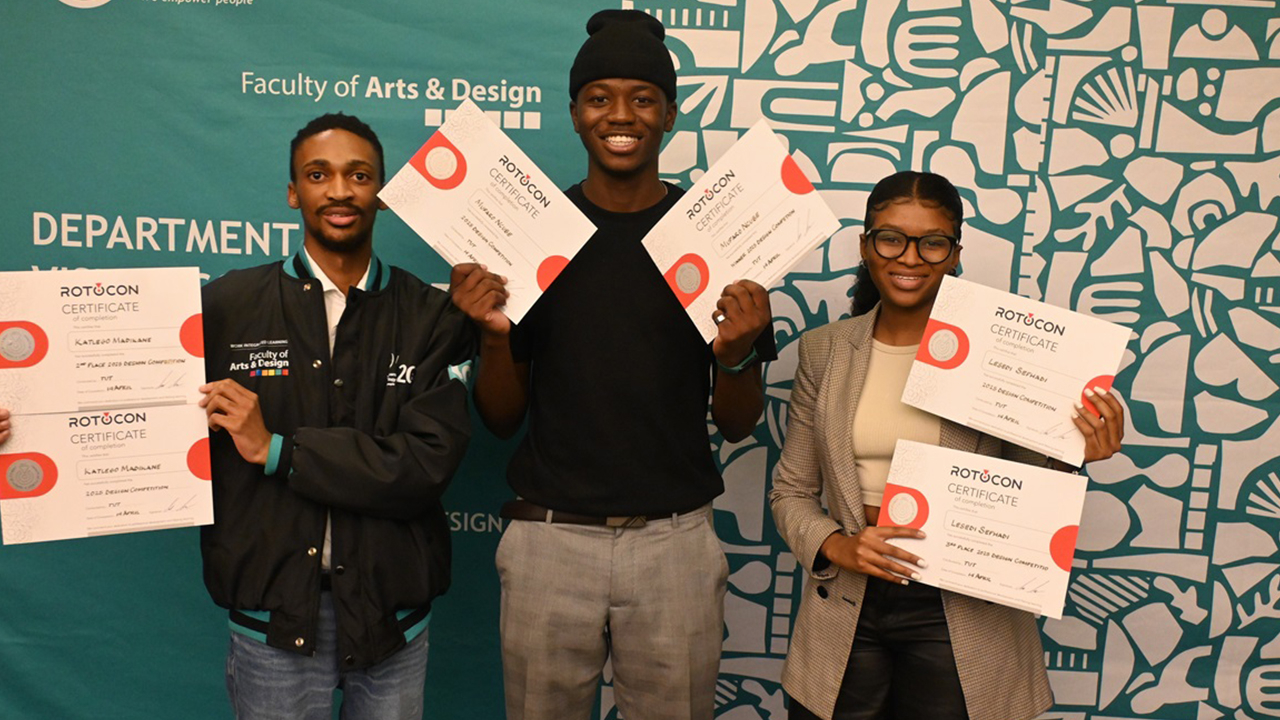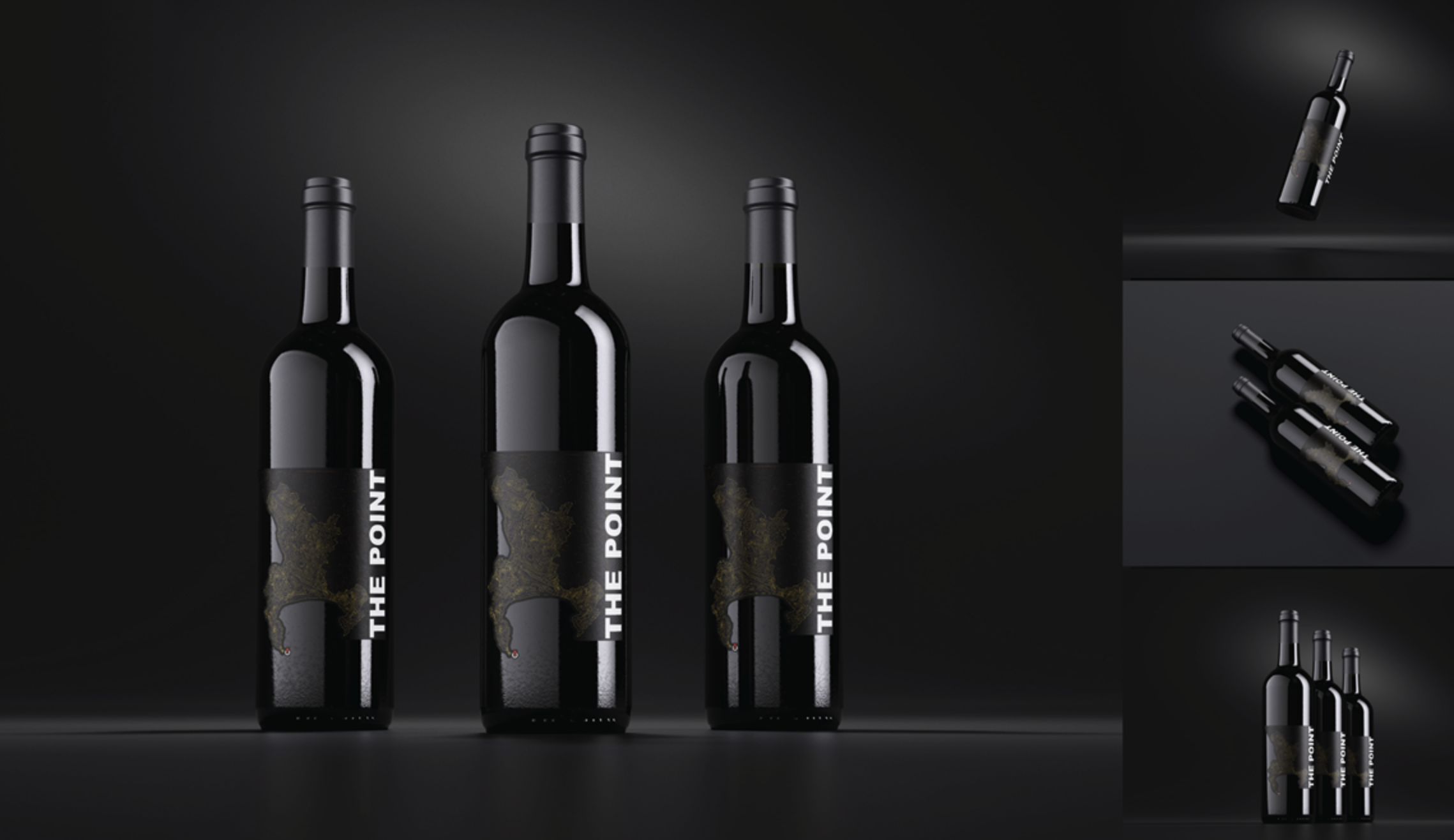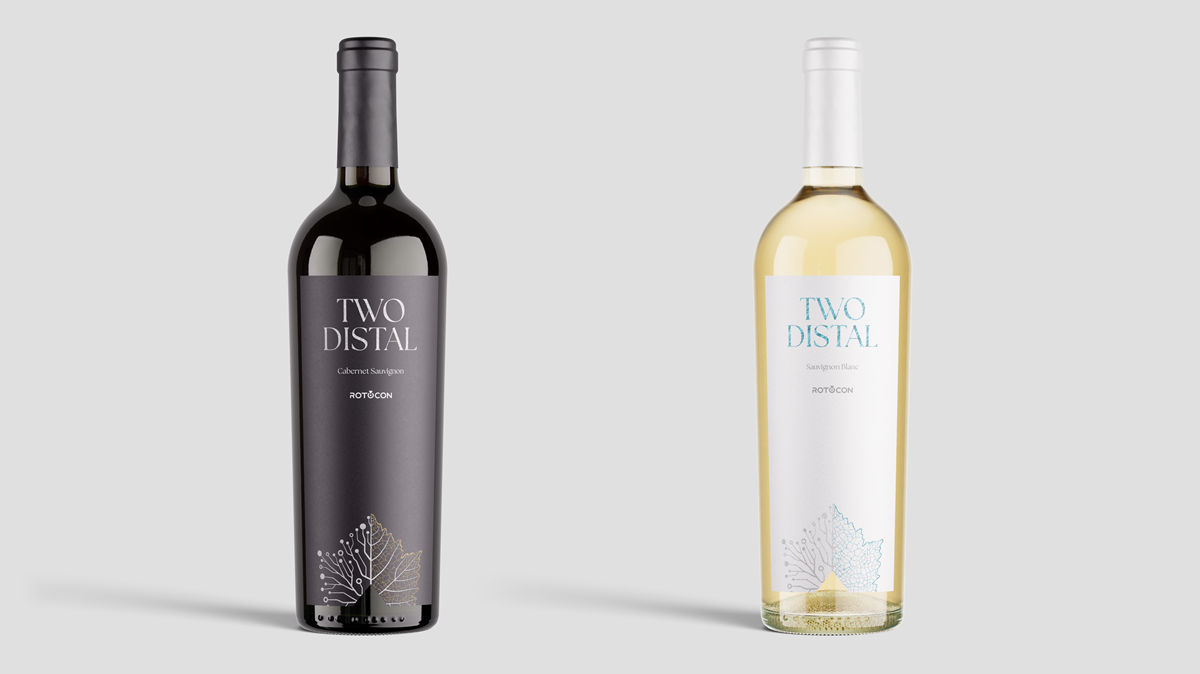Cultivating creativity through design competition
Print technology supplier Rotocon has transformed youth development from a corporate responsibility buzzword into a tangible industry impact through its annual wine label design competition.

The winning trio of the 2025 competition (from left) runner-up Katlego Madikane, overall winner Mufaro Ncube and second runner-up Lesedi Sephadi
South Africa’s label printing industry faces a familiar challenge: how to bridge the gap between academic learning and real-world application while nurturing the next generation of creative talent. For Rotocon, the answer lies not in traditional internship programs or graduate recruitment drives, but in a unique partnership that challenges students to think beyond their comfort zones.
Since 2023, the company has collaborated with Tshwane University of Technology (TUT) to create what has become one of the most anticipated events in South Africa’s design calendar. The annual wine label design competition, now in its third year, has evolved from a simple contest into a comprehensive skills development program that demonstrates how industry-academia partnerships can create meaningful opportunities for emerging designers.
Beyond the brief
Rather than simply requesting design submissions, Rotocon and its partners have developed a comprehensive learning experience that mirrors real-world client relationships, from initial briefing through final production.
Banie Stafford of B Creative, who spearheads the competition, delivers specialized lectures covering everything from printing processes and embellishments to typography and target market analysis. These sessions provide insider knowledge typically gained only through years of industry experience. ‘This isn’t just about creating visual displays,’ explains Schalk van Staden, an integrated communication design lecturer at TUT. ‘It’s a potential launchpad for careers.’

The educational component includes crucial business skills. Students learn to present comprehensive design pitches, articulate their creative decisions and defend their choices. This presentation component, introduced in the competition’s second year, reflects real-world client relationships in which designers must justify their concepts and demonstrate an understanding of production constraints.
The 2025 competition saw 60 students participate, nearly doubling the number of participants in the inaugural year and reflecting a growing awareness of the program’s value. The theme ‘Cultivate a life worth tasting’ challenged participants to consider both aesthetic appeal and production feasibility while developing designs that could realistically enter commercial production.
“This competition is more than a design challenge. It’s a reminder that, like great wine, a meaningful life takes time, integrity and collaboration to craft”
Students must factor in contemporary printing processes considerations that distinguish professional label design from general graphic design. These requirements force participants to understand how creative vision translates into physical products, bridging the gap between artistic expression and manufacturing reality.
Winner Mufaro Ncube’s ‘The Point’ design exemplifies this sophisticated approach. His topographical map concept of Cape Town, complete with die-cut elements and embossed finishes, demonstrates a nuanced understanding of how design and production technology intersect. The design also incorporates a hidden element, the Rotocon name topographically embedded into Cape Town’s map, showing how students learn to layer meaning and complexity into their work.

Runner-up Katlego Madikane’s ‘Two Distal’ designs for cabernet sauvignon and sauvignon blanc demonstrate another sophisticated approach, creating coordinated product families that maintain brand coherence across multiple wine varieties. Third-place winner Lesedi Sephadi’s ‘Ilanga’ pinotage and chardonnay designs showcase cultural authenticity combined with commercial viability.
Real-world exposure
The competition’s value extends beyond prize money, though the financial incentives are substantial. Winners receive up to 30,000 ZAR (1,700 USD), while runners-up earn 15,000 ZAR (850 USD). However, the program’s true value lies in providing exposure to industry professionals and production processes that would typically remain inaccessible to undergraduate students.
SA Litho Label Printers joined the partnership in 2024, fundamentally expanding the program’s scope by printing the winning designs and providing comprehensive factory tours for winners. General manager Dawrian Salies sees this as an essential investment rather than corporate charity: ‘Investing in youth and education is crucial for South Africa’s future.’
The partnership demonstrates how industry collaboration can enhance educational outcomes. When SA Litho’s desktop publishing interns led the production of winning labels, it created a cascade of learning opportunities. University students saw their designs come to life in commercial production, while entry-level professionals gained project management experience.
This hands-on production experience proves invaluable for students who may understand design principles but lack exposure to the constraints of manufacturing. Watching their concepts navigate pre-press preparation, color matching and finishing processes provides insights impossible to replicate in classroom settings. Students learn how their design choices impact production timelines, costs and quality outcomes.
The factory tours include detailed explanations of different printing technologies, substrate options and finishing techniques. Students observe how their theoretical knowledge applies in practice, understanding why certain design elements work while others create production challenges. These experiences frequently influence students’ subsequent design approaches, making them more industry-ready upon graduation.
National reach, fresh perspectives
Strategic geographic considerations have enhanced the competition’s impact in ways that might not have been anticipated during initial planning. By partnering with a Gauteng-based institution rather than Western Cape universities closer to the wine industry’s heartland, Rotocon deliberately sought fresh perspectives from students with limited exposure to the wine industry.
This decision initially raised questions about whether students unfamiliar with wine culture could create authentic designs. However, the results have consistently exceeded expectations, with participants producing innovative concepts that challenge industry conventions.
‘If you consider that most of these students have never set foot outside of Gauteng, let alone in the Cape Winelands, I was blown away by the research-driven designs that they implemented,’ notes Stafford of B Creative. This geographic separation has yielded unexpected creative benefits, allowing students to approach wine label design without preconceived industry conventions or stylistic limitations.

Herman Botes, head of TUT’s department of visual communication, confirms this advantage: ‘These students are not wine consumers at all and have no experience of the wine industry. The competition took them out of their comfort zones and exposed them to a different world.’
The research component becomes crucial when students lack direct experience with their design subject. Participants must investigate wine industry culture, understand consumer demographics and study existing market trends before developing their concepts. This research-first approach often produces more thoughtful, strategically grounded designs than purely intuitive creative responses.
Structured for success
The competition’s integration into TUT’s curriculum demonstrates how industry partnerships can enhance rather than disrupt academic programs. Planning begins a year in advance, with the project embedded from the beginning of the academic year rather than treated as an add-on activity.
This structured approach includes multiple revision cycles, development of presentation skills and comprehensive design pitches to industry judges.
Program coordinator Mohammed Jogie highlights the broader educational value: ‘This project allowed us to push innovation in the thought and design process and creative output. Another valuable lesson for the students was the real-world exposure they got.’
Industry impact and career development
The competition’s influence extends to broader industry transformation, creating pathways for career advancement while addressing skills shortages in specialized areas like label design. The program has become a recognized talent pipeline, with industry professionals now monitoring competition results to identify emerging designers.
The competition creates networking opportunities that often translate into internships, freelance projects or full-time employment. Several past participants have secured positions within the printing and packaging sector, leveraging competition exposure and industry connections gained through the program.
“This isn’t just about creating visual displays. It’s a potential launchpad for careers”
For the wine industry itself, the competition provides access to fresh design perspectives that can differentiate products in increasingly competitive markets. Wine producers seeking distinctive label designs now have visibility into emerging talent.
Michael Aengenvoort, CEO of Rotocon, sees this as part of the company’s broader commitment to industry development: ‘Despite the challenges that the youth of this beautiful country are facing, there’s incredible potential that can be unlocked.’
The program’s success has attracted attention from other industry sectors, with some companies exploring similar partnerships for packaging design, textile printing and related creative fields.
Mutual benefits
Successful industry-academia partnerships require mutual value creation, a principle that has guided the development of the competition. Universities gain access to industry expertise and real-world project opportunities, while companies identify emerging talent and contribute to skills development in their sector.
‘It shouldn’t be a situation where one party benefits more than the other,’ explains Botes. ‘We all got what we wanted out of the project, and it presented our students with valuable real-world learning opportunities.’
For Rotocon, the competition showcases its technology capabilities while demonstrating corporate citizenship.
Looking ahead
As the competition enters its fourth year, organizers are focused on maintaining quality while expanding impact. The increase from 30 participants in the inaugural year to 60 in 2025 demonstrates growing enthusiasm among students.
Stafford emphasizes continuous improvement: ‘Our aim is not just to organize a run-of-the-mill, nice-to-have competition. We’ll continue to step it up and provide students with a platform for recognition and growth.’
Rotocon’s approach offers a replicable model for other printing companies seeking to address skills development challenges. The key elements, such as advanced planning, curriculum integration, industry mentorship and tangible career opportunities, can be adapted across different educational institutions and market segments.
As Aengenvoort concluded in his 2025 keynote address: ‘This competition is more than a design challenge. It’s a reminder that, like great wine, a meaningful life takes time, integrity and collaboration to craft. The future of our industry and our world depends on the creativity and character you bring to the table.’
Stay up to date
Subscribe to the free Label News newsletter and receive the latest content every week. We'll never share your email address.


